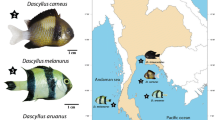Abstract
The asymmetry of karyotype previously regarded as a Family character of the Mantispidae is absent in 4 species representative of one of the species-groups tyxonomically distinguishable in the Mantispas of the Western Hemisphere. Further diversity is evident in the evolutionary loss of the Y chromosome in Plega dactylota Rehn and the substitution of a Neo-XY system for distance segregation in P. signata (Hagen). In the Mantispas pseudo- or “sticky” sex-bivalents are present at diakinesis with a maximum frequency of 50% in M. fuscicornis Banks. By final metaphase this is reduced to 2% or less except in M. uhleri Banks in which 6% of the spermatocytes retain sex-bivalents. Univalent autosomes, observed in all but one of the species studied, occur in less than 1% of the cells at first metaphase except in M. interrupta Say and Plega dactylota in which their frequency approaches 8%. The precocious segregation of these unconjoined autosomes shows that univalency, rather than any sex-related attribute, underlies distance segregation.
Similar content being viewed by others
References
Achtelig, M., Kristensen, N.P.: A re-examination of the relationships of the Raphidioptera (Insecta). Z. zool. Syst. Evol. 11, 268–274 (1973)
Hirai, H.: Notes on the chromosomes of the Osmyloidea (Neuroptera). Misc. Rep. Yamashita's Inst. Ornith. Zool. 6, 269–270 (1955)
Hirai, H.: Cytotaxonomic studies of the Japanese Neuroptera I. The Osmyloidea. Jap. J. Genet. 31, 54–64 (1956)
Hughes-Schrader, S.: Distance segregation and compound sex chromosomes in mantispids (Neuroptera: Mantispidae). Chromosoma (Berl.) 27, 101–129 (1969)
Hughes-Schrader, S.: Segregational mechanisms of sex chromosomes in Spongilla-flies (Neuroptera: Sisyridae). Chromosoma (Berl.) 52, 1–10 (1975a)
Hughes-Schrader, S.: Male meiosis in camel-flies (Raphidioptera: Neuropteriodea). Chromosoma (Berl.) 51, 99–110 (1975b)
Klingstedt, H.: Chromosome behavior and phylogeny in the Neuroptera. Nature (Lond.) 139, 468 (1937)
Naville, A., Beaumont, J. de: Recherches sur les chromosomes des Névroptères. Arch. d'Anat. micr. 29, 199–243 (1933)
Naville, A., Beaumont, J. de: Recherches sur les chromosomes des Névroptères. Part II. Arch. d'Anat. micr. 32, 271–302 (1936)
Parker, F.D., Stange, L.A.: Systematic and biological notes on the Tribe Platymantispini (Neuroptera: Mantispidae) and the description of a new species of Plega from Mexico. Canad. Entom. 97, 604–612 (1965)
Snow, R.: Alcoholic hydrochloric acid-carmine as a stain for chromosomes in squash preparations. Stain Technol. 38, 9–13 (1963)
Suomalainen, H.O.T.: Occurrence and phylogenetic significance of a true sex chromosome bivalent in a lace-wing, Boriomyia nervosa F. (Neuroptera, Hemerobiidae). Arch. Soc. Zool. Bot. Fenn. “Vanamo” 7, 45–49 (1952)
Author information
Authors and Affiliations
Additional information
Dedicated with affection and admiration to Professor Hans Bauer on the occasion of his 75th birthday
Rights and permissions
About this article
Cite this article
Hughes-Schrader, S. Diversity of chromosomal segregational mechanisms in Mantispids (Neuroptera: Mantispidae). Chromosoma 75, 1–17 (1979). https://doi.org/10.1007/BF00330620
Received:
Accepted:
Issue Date:
DOI: https://doi.org/10.1007/BF00330620




